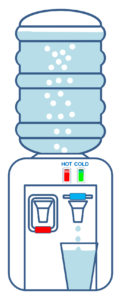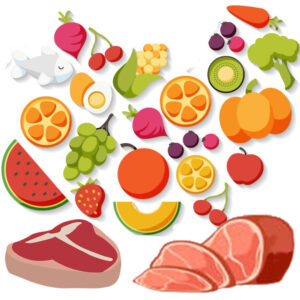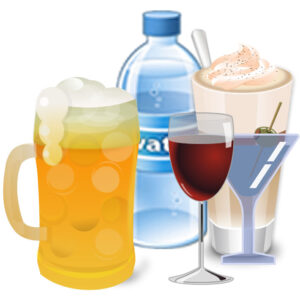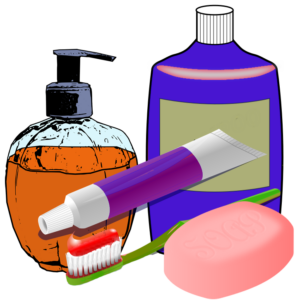Microplastics & Nanoplastics in Human Tissues: Exposures, Accumulation Patterns, and Implications
 Brian: Microplastics & nanoplastics have been shown to pass through the blood brain barrier. In studies it has been shown to adversely affect mammals. Exposure to these plastics can result in inhibition of acetylcholinesterase activity and altered neurotransmitter levels, which both may contribute to the reported behavioral changes[ii].
Brian: Microplastics & nanoplastics have been shown to pass through the blood brain barrier. In studies it has been shown to adversely affect mammals. Exposure to these plastics can result in inhibition of acetylcholinesterase activity and altered neurotransmitter levels, which both may contribute to the reported behavioral changes[ii].- Gastrointestinal Tract: Presence of microplastics & nanoplastics in the gastrointestinal tract, including the stomach and intestines. This suggests that ingested microplastics can accumulate in the digestive system, potentially raising concerns about their interaction with gastrointestinal tissues[iii]–[iv].
- Liver: Accumulation of these plastics are observed in the liver, a vital organ responsible for detoxification and metabolism. The study’s results indicate that microplastics can translocate to and accumulate in the liver tissues, posing potential challenges for liver function[v]–[vi].
- Lungs: Inhalation is identified as a potential route of exposure, and the accumulation of these plastics in the lungs suggests a direct impact on respiratory organs[vii]–[viii].
- Spleen: The spleen, a part of the immune system, is identified as another organ where these plastics are found. The study’s results imply that microplastics may circulate within the body and accumulate in organs associated with immune functions[ix]–[x].
- Kidneys: Microplastics & nanoplastics have been detected in kidney tissues, emphasizing their distribution in vital organs involved in filtration and waste excretion. The study suggests that microplastics can enter and accumulate in the kidneys[xi]–[xii].
Implications for Human Health: The study underscores the need to assess the potential health implications of microplastic accumulation in human tissues. While the precise health effects are still under investigation, the presence of microplastics in organs raises concerns about their impact on organ function, immune responses, and overall health.
The study you provided, Microplastics in the Human Food Chain: A Review, investigates the presence of microplastics in various components of the human food chain. Here are the key findings from the study regarding where microplastics are found in the food chain:
Microplastics & Nanoplastics in the Human Food Chain: A Review
The study comprehensively explores the presence of microplastics in different stages of the human food chain, encompassing various food items and sources[xiii]–[xiv].
 Seafood: Microplastics are prominently found in seafood, including fish[xv] and shellfish[xvi]. The study reveals that aquatic organisms can ingest microplastics from contaminated water, and these particles accumulate in their tissues. For example, in one study the 62% of the Atlantic chub mackerel were found to have microplastic contamination in the gastrointestinal tract[xvii]. Current studies estimate that 88% of the sea surface is contaminated with plastic waste[xviii].Consequently, seafood products such as fish and shellfish can become sources of microplastic exposure for humans.
Seafood: Microplastics are prominently found in seafood, including fish[xv] and shellfish[xvi]. The study reveals that aquatic organisms can ingest microplastics from contaminated water, and these particles accumulate in their tissues. For example, in one study the 62% of the Atlantic chub mackerel were found to have microplastic contamination in the gastrointestinal tract[xvii]. Current studies estimate that 88% of the sea surface is contaminated with plastic waste[xviii].Consequently, seafood products such as fish and shellfish can become sources of microplastic exposure for humans.

Salt: The study identifies salt as a notable source of microplastics in the human diet[xix]. Seawater, being a reservoir for microplastics, can contribute to the contamination of sea salt. The processing and production of salt can introduce microplastics, ultimately reaching the consumer. When purchasing any sea salt products make sure the company is a reputable company and tests for microplastics and other contaminates such as heavy metals[xx].
 Bottled Water: Microplastics are detected in bottled water, suggesting that the packaging and production processes may introduce these particles. In one study, the results were alarming. Originally plastic contamination focused around microplastics, which are much larger the nanoplastics. In one study the researchers focused on nanoplastics. They found, on average, that a one liter of bottled water contained about 240,000 pieces of plastic, and about 90% of the plastics were nanoplastics. This was 10 to 100 times more plastic particles than discovered in earlier studies[xxi].
Bottled Water: Microplastics are detected in bottled water, suggesting that the packaging and production processes may introduce these particles. In one study, the results were alarming. Originally plastic contamination focused around microplastics, which are much larger the nanoplastics. In one study the researchers focused on nanoplastics. They found, on average, that a one liter of bottled water contained about 240,000 pieces of plastic, and about 90% of the plastics were nanoplastics. This was 10 to 100 times more plastic particles than discovered in earlier studies[xxi].
 Processed Foods: Microplastics are found in certain processed foods. The study indicates that packaging materials and processing equipment can introduce microplastics into food products. The inclusion of recycled plastics in packaging materials is identified as a potential source of contamination. Plastic cutting boards appear to be the source of microplastics in meat[xxii].
Processed Foods: Microplastics are found in certain processed foods. The study indicates that packaging materials and processing equipment can introduce microplastics into food products. The inclusion of recycled plastics in packaging materials is identified as a potential source of contamination. Plastic cutting boards appear to be the source of microplastics in meat[xxii].
 Meats, Vegetables and Fruits: While the study emphasizes a lower prevalence of microplastics in plant-based foods as compared to meats[xxiii], seafood, vegetables and fruits are not exempt. Agricultural practices, including the use of plastic mulch and irrigation systems, can contribute to the presence of microplastics in these food items.
Meats, Vegetables and Fruits: While the study emphasizes a lower prevalence of microplastics in plant-based foods as compared to meats[xxiii], seafood, vegetables and fruits are not exempt. Agricultural practices, including the use of plastic mulch and irrigation systems, can contribute to the presence of microplastics in these food items.
 Beverages: Microplastics are detected in various beverages, including beer[xxiv] and tea. Microplastics are tiny particles of plastic that are less than 5 millimeters in size. They can be generated through the breakdown of larger plastic items, such as bottles and packaging, or they can be intentionally manufactured at the microscale for various applications. Concerns about the presence of microplastics in beverages have arisen due to their potential impact on human health and the environment.
Beverages: Microplastics are detected in various beverages, including beer[xxiv] and tea. Microplastics are tiny particles of plastic that are less than 5 millimeters in size. They can be generated through the breakdown of larger plastic items, such as bottles and packaging, or they can be intentionally manufactured at the microscale for various applications. Concerns about the presence of microplastics in beverages have arisen due to their potential impact on human health and the environment.
 Body Care, Cosmetic and Personal Hygiene Products: They are used in various cosmetic and personal care items for their exfoliating, texturizing, and stabilizing properties. They can be found in everything, including body washes, soap[xxv], toothpaste[xxvi] and toothbrushes[xxvii].
Body Care, Cosmetic and Personal Hygiene Products: They are used in various cosmetic and personal care items for their exfoliating, texturizing, and stabilizing properties. They can be found in everything, including body washes, soap[xxv], toothpaste[xxvi] and toothbrushes[xxvii].
Per- and Polyfluoroalkyl Substances (PFAS) in Microplastics[xxviii]:
- Adsorption and Absorption: PFAS can adsorb or absorb onto the surface of microplastics. This can occur when PFAS-contaminated water comes into contact with microplastics, leading to the attachment of PFAS molecules onto the plastic surface.
- Persistence: Microplastics, being persistent in the environment, can act as carriers for PFAS. Due to their small size and widespread distribution, microplastics have the potential to transport PFAS over long distances.
- Contaminated Sources: PFAS can originate from various sources such as industrial discharges, atmospheric deposition, and the breakdown of PFAS-containing products. If these sources coexist with microplastics, there’s a potential for PFAS to associate with microplastics in the environment.
Abundance of PFAS in the Environment[xxix]–[xxx]:
- Water Bodies: PFAS are often detected in surface water and groundwater. Runoff from contaminated areas, industrial discharges, and atmospheric deposition contribute to the presence of PFAS in water bodies.
- Soil: PFAS can accumulate in soil, especially in areas where PFAS-containing products are used or where industrial activities release these substances. The persistence of PFAS in soil contributes to their presence in the environment.
- Air: PFAS have been identified in the atmosphere due to their release from industrial sources and other contamination routes. Atmospheric transport can contribute to the widespread distribution of PFAS. It is estimated that on average, one person inhales up to 22,000,000 micro and Neoplastic particles annually[xxxi]–[xxxii]–[xxxiii]–[xxxiv].
Bioaccumulation: PFAS can bioaccumulate in organisms, including human, aquatic and other terrestrial species. They can build up in the body[xxxv]. This bioaccumulation can also contribute to the presence of PFAS in the food chain, affecting various ecosystems.
IMPORTANT TIP: it is best to rinse off any area of the body after you use any body care or personal hygiene product. It is also a good idea to thrown out any plastic cutting boards, and replace them with board that are made of total natural products such as wood[xxxvi].
Citations
[i] Li, Yue & Tao, Le & Wang, Qiong & Wang, Fengbang & li, Gang & Song, Maoyong. (2023). Potential Health Impact of Microplastics: A Review of Environmental Distribution, Human Exposure, and Toxic Effects. Environment & Health. 10.1021/envhealth.3c00052.
[ii] Prüst M, Meijer J, Westerink RHS. The plastic brain: neurotoxicity of micro- and nanoplastics. Part Fibre Toxicol. 2020 Jun 8;17(1):24. doi: 10.1186/s12989-020-00358-y. PMID: 32513186; PMCID: PMC7282048.
[iii] Fournier E, Leveque M, Ruiz P, Ratel J, Durif C, Chalancon S, Amiard F, Edely M, Bezirard V, Gaultier E, Lamas B, Houdeau E, Lagarde F, Engel E, Etienne-Mesmin L, Blanquet-Diot S, Mercier-Bonin M. Microplastics: What happens in the human digestive tract? First evidences in adults using in vitro gut models. J Hazard Mater. 2023 Jan 15;442:130010. doi: 10.1016/j.jhazmat.2022.130010. Epub 2022 Sep 21. PMID: 36182891.
[iv] Gruber ES, Stadlbauer V, Pichler V, Resch-Fauster K, Todorovic A, Meisel TC, Trawoeger S, Hollóczki O, Turner SD, Wadsak W, Vethaak AD, Kenner L. To Waste or Not to Waste: Questioning Potential Health Risks of Micro- and Nanoplastics with a Focus on Their Ingestion and Potential Carcinogenicity. Expo Health. 2023;15(1):33-51. doi: 10.1007/s12403-022-00470-8. Epub 2022 Mar 22. PMID: 36873245; PMCID: PMC9971145.
[v] Yin J, Ju Y, Qian H, Wang J, Miao X, Zhu Y, Zhou L, Ye L. Nanoplastics and Microplastics May Be Damaging Our Livers. Toxics. 2022 Oct 4;10(10):586. doi: 10.3390/toxics10100586. PMID: 36287866; PMCID: PMC9610555.
[vi] Haldar S, Yhome N, Muralidaran Y, Rajagopal S, Mishra P. Nanoplastics Toxicity Specific to Liver in Inducing Metabolic Dysfunction-A Comprehensive Review. Genes (Basel). 2023 Feb 26;14(3):590. doi: 10.3390/genes14030590. PMID: 36980862; PMCID: PMC10048484.
[vii] Saha SC, Saha G. Effect of microplastics deposition on human lung airways: A review with computational benefits and challenges. Heliyon. 2024 Jan 11;10(2):e24355. doi: 10.1016/j.heliyon.2024.e24355. PMID: 38293398; PMCID: PMC10826726.
[viii] Woo JH, Seo HJ, Lee JY, Lee I, Jeon K, Kim B, Lee K. Polypropylene nanoplastic exposure leads to lung inflammation through p38-mediated NF-κB pathway due to mitochondrial damage. Part Fibre Toxicol. 2023 Jan 10;20(1):2. doi: 10.1186/s12989-022-00512-8. PMID: 36624477; PMCID: PMC9829531.
[ix] Zhang Q, Zhang Y, Jing L, Zhao H. Microplastics induced inflammation in the spleen of developmental Japanese quail (Coturnix japonica) via ROS-mediated p38 MAPK and TNF signaling pathway activation1. Environ Pollut. 2024 Jan 15;341:122891. doi: 10.1016/j.envpol.2023.122891. Epub 2023 Nov 9. PMID: 37951530.
[x] Tang X, Fan X, Xu T, He Y, Chi Q, Li Z, Li S. Polystyrene nanoplastics exacerbated lipopolysaccharide-induced necroptosis and inflammation via the ROS/MAPK pathway in mice spleen. Environ Toxicol. 2022 Oct;37(10):2552-2565. doi: 10.1002/tox.23618. Epub 2022 Jul 14. PMID: 35833596.
[xi] La Porta E, Exacoustos O, Lugani F, Angeletti A, Chiarenza DS, Bigatti C, Spinelli S, Kajana X, Garbarino A, Bruschi M, Candiano G, Caridi G, Mancianti N, Calatroni M, Verzola D, Esposito P, Viazzi F, Verrina E, Ghiggeri GM. Microplastics and Kidneys: An Update on the Evidence for Deposition of Plastic Microparticles in Human Organs, Tissues and Fluids and Renal Toxicity Concern. Int J Mol Sci. 2023 Sep 21;24(18):14391. doi: 10.3390/ijms241814391. PMID: 37762695; PMCID: PMC10531672.
[xii] Meng X, Zhang J, Wang W, Gonzalez-Gil G, Vrouwenvelder JS, Li Z. Effects of nano- and microplastics on kidney: Physicochemical properties, bioaccumulation, oxidative stress and immunoreaction. Chemosphere. 2022 Feb;288(Pt 3):132631. doi: 10.1016/j.chemosphere.2021.132631. Epub 2021 Oct 21. PMID: 34688716.
[xiii] Lee Y, Cho J, Sohn J, Kim C. Health Effects of Microplastic Exposures: Current Issues and Perspectives in South Korea. Yonsei Med J. 2023 May;64(5):301-308. doi: 10.3349/ymj.2023.0048. PMID: 37114632; PMCID: PMC10151227.
[xiv] Meng X, Zhang J, Wang W, Gonzalez-Gil G, Vrouwenvelder JS, Li Z. Effects of nano- and microplastics on kidney: Physicochemical properties, bioaccumulation, oxidative stress and immunoreaction. Chemosphere. 2022 Feb;288(Pt 3):132631. doi: 10.1016/j.chemosphere.2021.132631. Epub 2021 Oct 21. PMID: 34688716.
[xv] Alberghini L, Truant A, Santonicola S, Colavita G, Giaccone V. Microplastics in Fish and Fishery Products and Risks for Human Health: A Review. Int J Environ Res Public Health. 2022 Dec 31;20(1):789. doi: 10.3390/ijerph20010789. PMID: 36613111; PMCID: PMC9819327.
[xvi] Pironti C, Ricciardi M, Motta O, Miele Y, Proto A, Montano L. Microplastics in the Environment: Intake through the Food Web, Human Exposure and Toxicological Effects. Toxics. 2021 Sep 16;9(9):224. doi: 10.3390/toxics9090224. PMID: 34564375; PMCID: PMC8473407.
[xvii] Pironti C, Ricciardi M, Motta O, Miele Y, Proto A, Montano L. Microplastics in the Environment: Intake through the Food Web, Human Exposure and Toxicological Effects. Toxics. 2021 Sep 16;9(9):224. doi: 10.3390/toxics9090224. PMID: 34564375; PMCID: PMC8473407.
[xviii] Condor Ferries, Plastic in the Ocean Statistics 2020. [(accessed on 20 September 2022)].
[xix] Di Salvo E, Tardugno R, Nava V, Naccari C, Virga A, Salvo A, Corbo F, Clodoveo ML, Cicero N. Gourmet Table Salts: The Mineral Composition Showdown. Toxics. 2023 Aug 15;11(8):705. doi: 10.3390/toxics11080705. PMID: 37624210; PMCID: PMC10459412.
[xx] https://www.selinanaturally.com/faqs#collapse10
[xxi] Qian N, Gao X, Lang X, Deng H, Bratu TM, Chen Q, Stapleton P, Yan B, Min W. Rapid single-particle chemical imaging of nanoplastics by SRS microscopy. Proc Natl Acad Sci U S A. 2024 Jan 16;121(3):e2300582121. doi: 10.1073/pnas.2300582121. Epub 2024 Jan 8. PMID: 38190543; PMCID: PMC10801917.
[xxii] Habib RZ, Poulose V, Alsaidi R, Al Kendi R, Iftikhar SH, Mourad AI, Kittaneh WF, Thiemann T. Plastic cutting boards as a source of microplastics in meat. Food Addit Contam Part A Chem Anal Control Expo Risk Assess. 2022 Mar;39(3):609-619. doi: 10.1080/19440049.2021.2017002. Epub 2022 Jan 27. PMID: 35084287.
[xxiii] Habib RZ, Kindi RA, Salem FA, Kittaneh WF, Poulose V, Iftikhar SH, Mourad AI, Thiemann T. Microplastic Contamination of Chicken Meat and Fish through Plastic Cutting Boards. Int J Environ Res Public Health. 2022 Oct 18;19(20):13442. doi: 10.3390/ijerph192013442. PMID: 36294029; PMCID: PMC9602623.
[xxiv] Liebezeit G., Liebezeit E. (2014). Synthetic particles as contaminants in German beers. Food Addit. Contam. 31, 1574–1578. 10.1080/19440049.2014.945099
[xxv] G.G.N. Thushari, J.D.M. Senevirathna,Plastic pollution in the marine environment,Heliyon,Volume 6, Issue 8,2020,e04709, ISSN 2405-8440
[xxvi] Meegoda JN, Hettiarachchi MC. A Path to a Reduction in Micro and Nanoplastics Pollution. Int J Environ Res Public Health. 2023 Apr 18;20(8):5555. doi: 10.3390/ijerph20085555. PMID: 37107837; PMCID: PMC10139116.
[xxvii] Fang C, Gopalan S, Zhang X, Xu L, Niu J, Naidu R. Raman imaging to identify microplastics released from toothbrushes: algorithms and particle analysis. Environ Pollut. 2023 Nov 15;337:122510. doi: 10.1016/j.envpol.2023.122510. Epub 2023 Sep 7. PMID: 37689132.
[xxviii] Scott JW, Gunderson KG, Green LA, Rediske RR, Steinman AD. Perfluoroalkylated Substances (PFAS) Associated with Microplastics in a Lake Environment. Toxics. 2021 May 11;9(5):106. doi: 10.3390/toxics9050106. PMID: 34064651; PMCID: PMC8151042.
[xxix] https://www.ans.org/news/article-5361/the-ubiquity-of-pfas-an-emerging-issue-in-decommissioning/
[xxx] Langenbach B, Wilson M. Per- and Polyfluoroalkyl Substances (PFAS): Significance and Considerations within the Regulatory Framework of the USA. Int J Environ Res Public Health. 2021 Oct 23;18(21):11142. doi: 10.3390/ijerph182111142. PMID: 34769660; PMCID: PMC8583519.
[xxxi] Kieran D. Cox et al., “Human Consumption of Microplastics,” Environmental Science & Technology 53, no. 12 (June 18, 2019): 7071, https://doi.org/10.1021/acs.est.9b01517
[xxxii] Kurunthachalam Kannan and Krishnamoorthi Vimalkumar, “A Review of Human Exposure to Microplastics and Insights Into Microplastics as Obesogens,” Frontiers in Endocrinology 12 (2021): 978, https://doi.org/10.3389/fendo.2021.724989
[xxxiii] Zhang et al., “Atmospheric Microplastics,” 12; Qun Zhang et al., “A Review of Microplastics in Table Salt, Drinking Water, and Air: Direct Human Exposure,” Environmental Science & Technology 54, no. 7 (April 7, 2020): 3747, https://doi.org/10.1021/acs.est.9b04535
[xxxiv] Alvise Vianello et al., “Simulating Human Exposure to Indoor Airborne Microplastics Using a Breathing Thermal Manikin,” Scientific Reports 9, no. 1 (June 17, 2019): 8670, https://doi.org/10.1038/s41598-019-45054-w
[xxxv] Mohamed Nor N.H., Kooi M., Diepens N.J., Koelmans A.A. Lifetime Accumulation of Microplastic in Children and Adults. Environ. Sci. Technol. 2021;55:5084–5096. doi: 10.1021/acs.est.0c07384.
[xxxvi] Habib RZ, Kindi RA, Salem FA, Kittaneh WF, Poulose V, Iftikhar SH, Mourad AI, Thiemann T. Microplastic Contamination of Chicken Meat and Fish through Plastic Cutting Boards. Int J Environ Res Public Health. 2022 Oct 18;19(20):13442. doi: 10.3390/ijerph192013442. PMID: 36294029; PMCID: PMC9602623.


